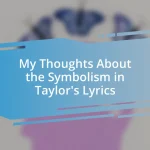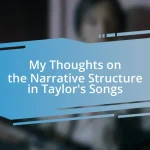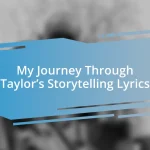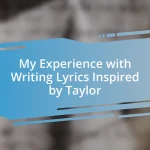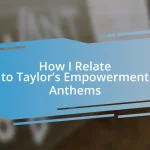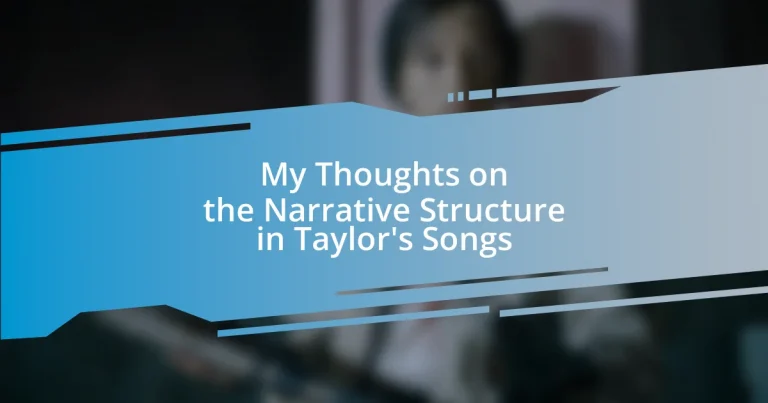Key takeaways:
- Narrative structure in songs fosters emotional connections, allowing listeners to reflect on their own experiences through relatable storytelling.
- Taylor Swift’s songwriting skillfully blends personal anecdotes with universal themes, evolving her narratives to resonate with her changing audience.
- Swift’s use of vivid imagery, dialogue, and narrative arcs enhances the storytelling in her music, creating a powerful listening experience that sparks personal memories and introspection.
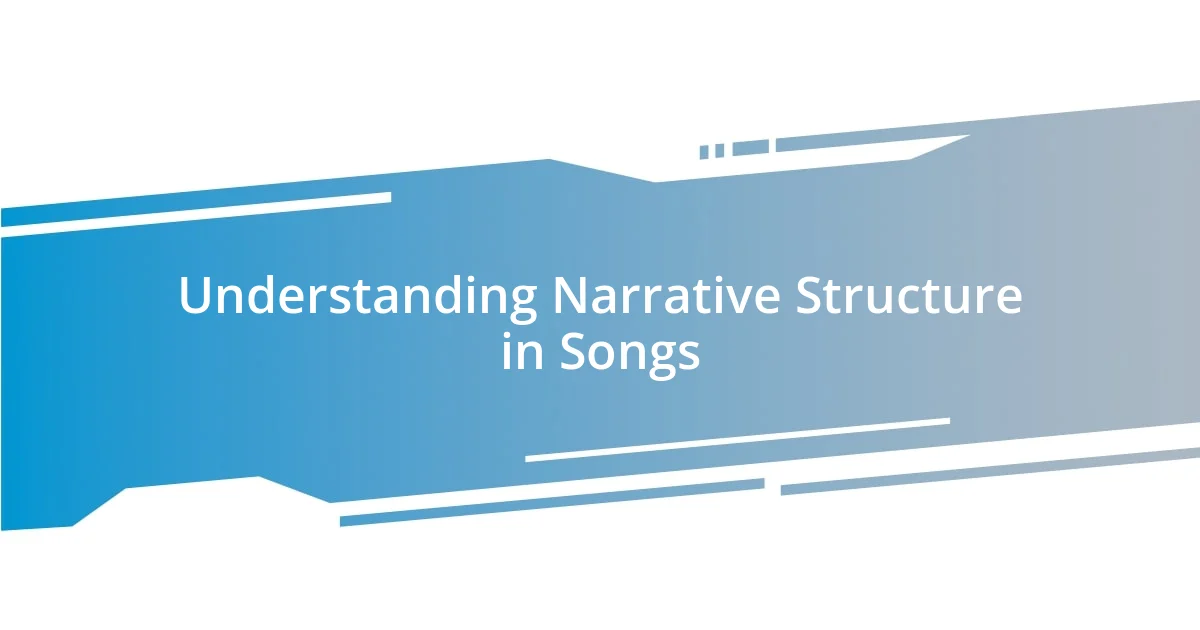
Understanding Narrative Structure in Songs
When I listen to songs, I often find myself drawn into a vivid world where stories unfold. The narrative structure in music acts like a thread weaving through each track, guiding the listener through emotions and experiences. Have you ever felt like a song encapsulates a moment in your life so perfectly that it almost feels like it belongs to you?
A well-crafted narrative in a song can create a sense of intimacy, almost like sharing a secret between friends. For instance, I remember hearing a particular song on a long drive, where the lyrics seemed to parallel my own journey. It’s fascinating how such stories can resonate deeply, making the music feel like both an escape and a mirror reflecting our own lives.
Songs often blend personal anecdotes with universal themes, allowing listeners to find their own meanings. Think about the last time you listened to a storytelling song; did it remind you of love, loss, or a turning point in your life? For me, the ability of narrative-driven songs to convey complex emotions through relatable stories is what makes them truly enchanting.
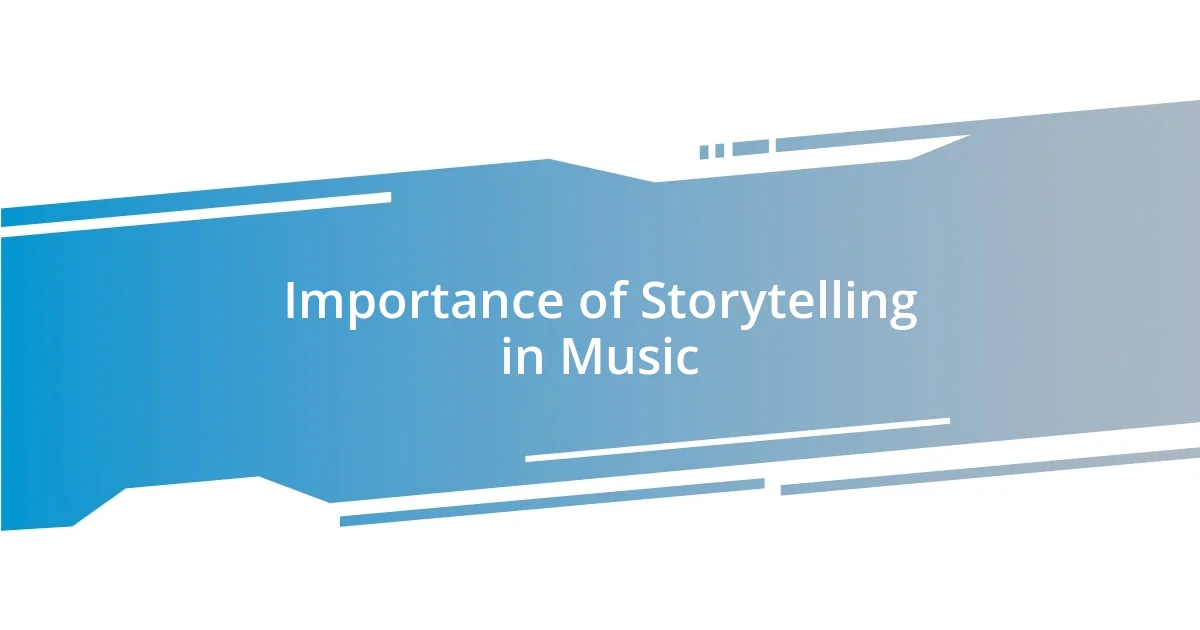
Importance of Storytelling in Music
Storytelling in music is vital because it fosters emotional connections between the artist and the listener. There’s something unique about lyrics that tell a story. I remember hearing “The Night the Lights Went Out in Georgia” for the first time. The tale of betrayal and loss captured my imagination—it felt like a gripping novella set to music. This kind of storytelling can transport us, allowing us to experience emotions that may otherwise be buried deep within.
- Engages listeners by evoking personal memories.
- Helps listeners process complex emotions through relatable narratives.
- Creates a shared experience that transcends individual backgrounds.
- Allows artists to express their truths in a way that feels authentic and relatable.
- Encourages reflection on one’s own life experiences, fostering deeper connections to the music.

Overview of Taylor’s Songwriting Style
Taylor Swift’s songwriting style is a masterclass in blending personal experiences with broader thematic elements. Her narratives often paint vivid pictures, pulling listeners into her world through rich imagery and emotional honesty. I remember when I first heard “All Too Well,” the way it crafted a story with such intricate details felt like eavesdropping on a heartfelt conversation. This kind of lyricism not only captivates but also invites the audience to reflect on their own memories.
In my experience, Swift draws from her life and relationships, transforming her personal narratives into universal tales. Her ability to embody complex emotions in a way that feels both intimate and relatable is truly remarkable. Take “Blank Space,” for example; it’s not just about a tumultuous romance but rather a witty commentary on public perception and dating culture. This duality in her storytelling keeps listeners engaged and invested in her journey.
What strikes me as particularly fascinating is her evolution as a songwriter. Early on, she focused on teenage experiences, but as she matured, so did her narratives. Songs like “The Archer” explore vulnerability and self-reflection, showing that her storytelling grows with her audience. It’s a testament to how personal narratives can be both deeply private yet widely relatable.
| Characteristic | Example |
|---|---|
| Personal Anecdotes | Swift often includes specific details from her life, making the listener feel connected. |
| Emotional Depth | Her songs express complex feelings that resonate with universal experiences. |
| Evolution | Swift’s narrative style evolves as she matures, reflecting changes in her life and audience. |
| Imagery | Her use of vivid imagery invites listeners to visualize the story being told. |

Common Themes in Taylor’s Lyrics
When diving into Taylor Swift’s lyrics, common themes often emerge, painting a nuanced picture of love and heartbreak. I can’t help but think back to my own experiences when I hear songs like “Love Story.” It evokes that feeling of young love, with all its exhilaration and uncertainty. Swift captures that bittersweet essence beautifully, reminding us of the intensity of those formative emotions.
Another prevalent theme is self-discovery and growth, something many of us can relate to. I recall listening to “Shake It Off,” and it served as a refreshing reminder to shake off negativity and embrace oneself. This anthem of resilience shows how she channels personal struggles into empowering messages, which can uplift listeners like me during tough times.
Additionally, her exploration of relationships often reflects the complexities of fame and public perception. “The Man” stands out to me for its clever critique of gender dynamics in society, prompting questions about how differently we perceive success based on gender. I’ve found that songs like this not only resonate personally but also spark conversations about broader societal issues. They remind us that beneath the catchy melodies lie profound insights worthy of contemplation.

Analysis of Specific Taylor’s Songs
One song that deeply resonates with me is “Dear John.” The storytelling is raw and confrontational, capturing the essence of betrayal and heartbreak. I remember listening to it late at night, feeling a wave of familiarity wash over me as I reflected on my own experiences with shattered trust. Swift’s candid approach compels us to consider our own narratives surrounding love and loss, doesn’t it?
In contrast, “The Story of Us” presents a narrative of disconnection. The clever use of metaphor in this song, likening a relationship to a storyline, strikes a chord with many listeners. It reminds me of the many times I found myself assessing the chapters of my own life, wondering when the narrative shifted from romance to uncertainty. The way she articulates feelings of isolation amidst a once-shared connection is a powerful reflection of human experience.
Then, there’s “All Too Well.” The vivid imagery and detailed storytelling transport me back to specific memories, making it feel as if I’m reliving my own moments of nostalgia and pain. I find myself pondering—how is it that a song can encapsulate entire experiences in just a few verses? Swift’s ability to intricately weave sensory details and emotional truths is simply breathtaking, creating a storyline that lingers in the mind long after the final note plays.

Techniques Used in Narrative Songwriting
When it comes to narrative songwriting, one powerful technique is the use of vivid imagery. I often find myself transported to the scenes Swift paints with her words, like the chilly autumn days described in “All Too Well.” This technique not only sets a tone but also evokes emotions that resonate on a personal level. It’s amazing how a simple description can trigger a flood of memories—don’t you feel that rush when a song takes you back?
Another compelling method is the incorporation of dialogue, which brings her stories to life. “The Story of Us” features snippets of conversations that instantly make the listener feel like an observer in a relationship’s unraveling. I remember the first time I heard it; I felt like I was eavesdropping on a breakup, which added an intimacy that’s hard to shake. Isn’t it fascinating how dialogue can create such a strong connection between the artist and the listener?
Lastly, narrative arcs play a critical role in Swift’s songwriting. Songs like “Fifteen” take us through a journey of growth and self-discovery, showcasing how experiences shape who we become. Reflecting on my own adolescent years, I can relate to that moment when you realize things don’t always go as planned. How does one encapsulate the complexities of youth into a few verses? Swift does it effortlessly, making the lessons learned feel both personal and universal.
